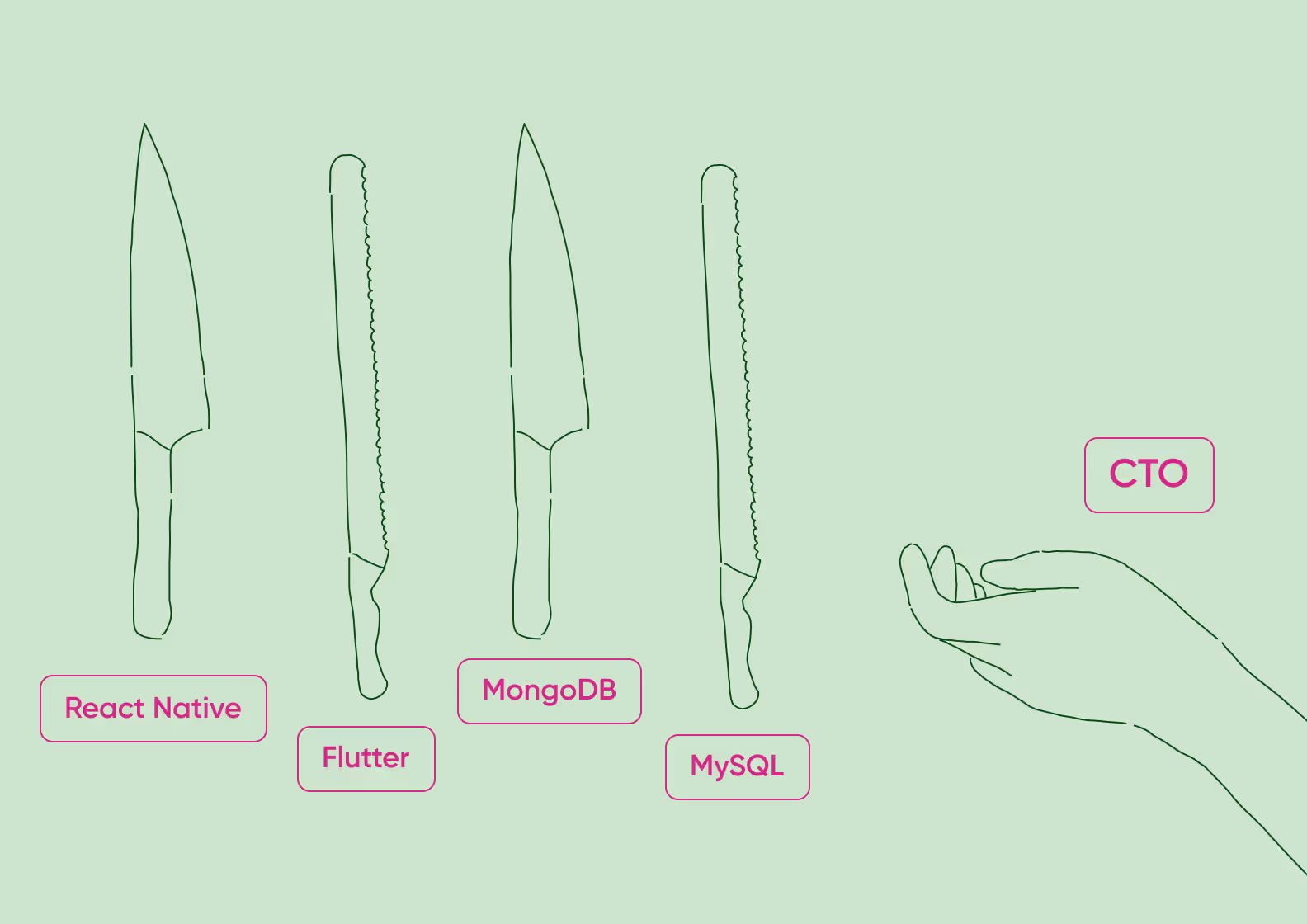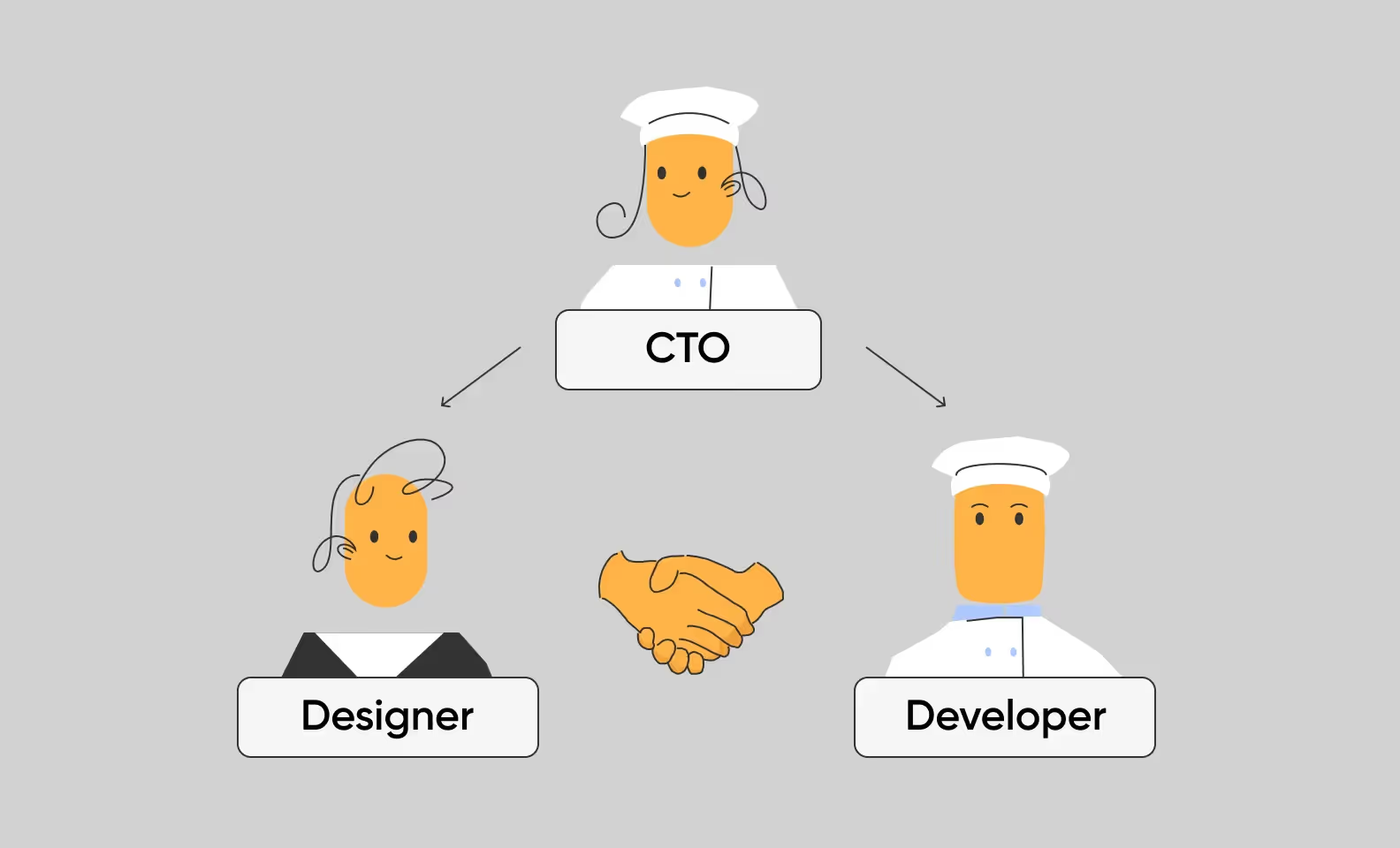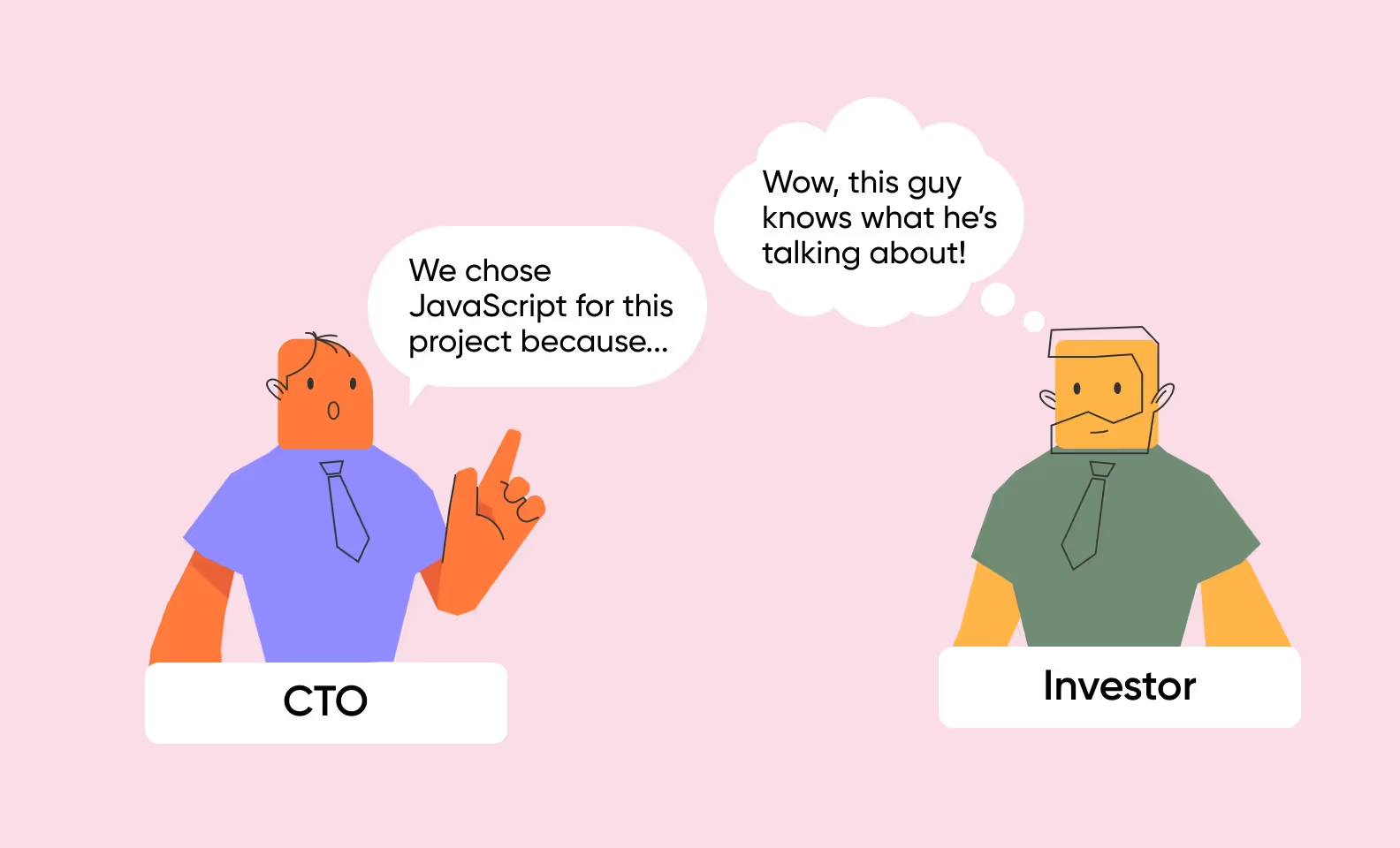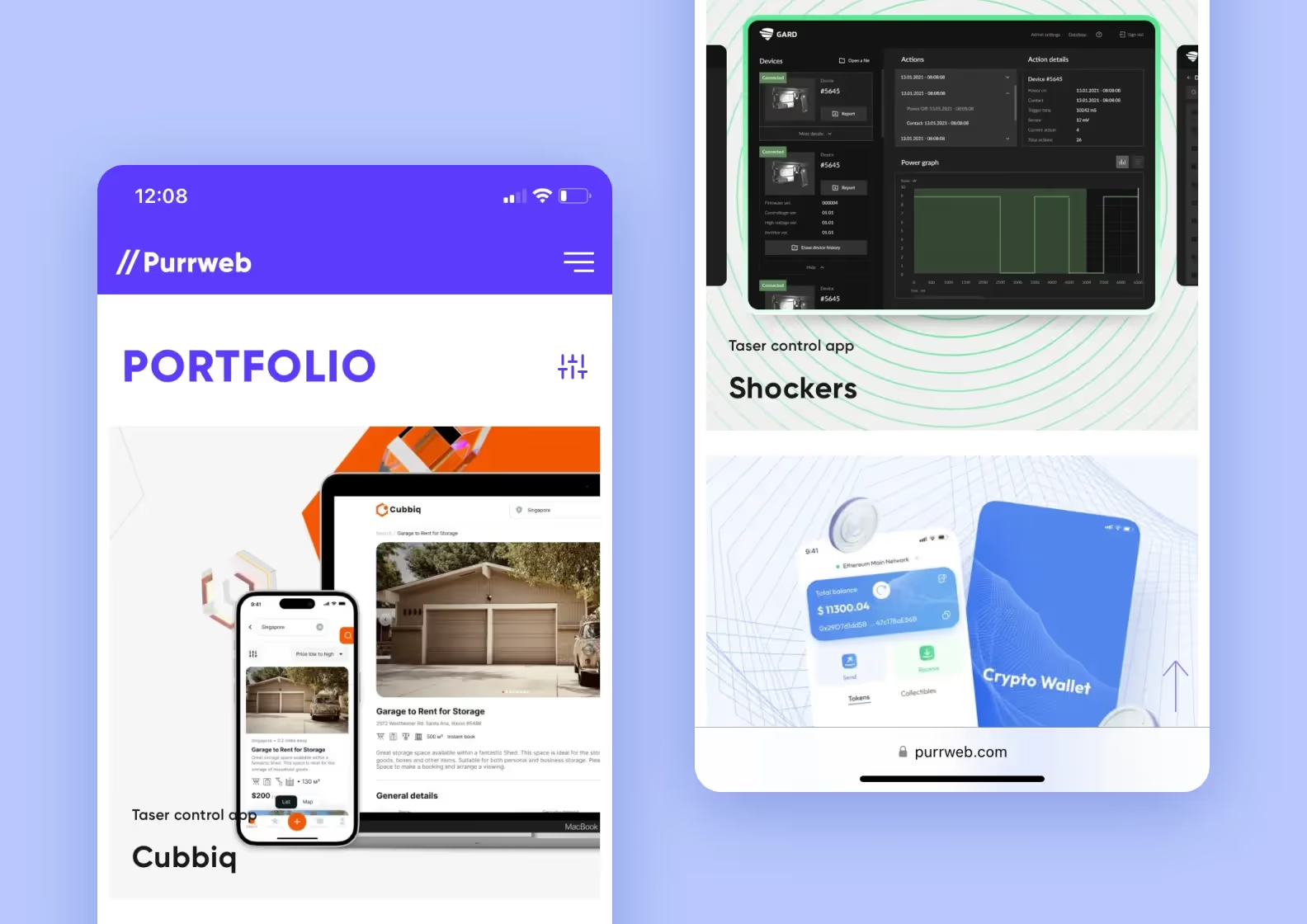


Some founders don’t know where to start when it comes to development. They may have figured out the idea and tested it with their potential clients, but they don’t know whether it’s technically feasible.
In this case, CTO as a Service (CTOaaS) can help. Not only can they lend their expertise and help with leading development, but you can also use their advice to optimize development processes and save money in the long run. In this article, we’ll tell you what CTOaaS is, why you should be using it, and how to find one.

The CTO as a Service is a manager who takes responsibility for the tech-related part of the business. If the company is making an app, the CTO’s job is to make sure the product releases on schedule and without any major issues.
Imagine a restaurant. In this case, the CTO is essentially a chef. They design the menu, make sure the process goes smoothly, and manage the kitchen staff. If there’s an unexpected problem — say, a lunch time rush — the chef jumps in to help.
The CTO in a startup or a SME does similar things. They choose a development approach, hire programming specialists, and ensure that the team meets every deadline.
Let’s take a look at 4 most popular CTO services:
The type of CTO you should get depends on the resources of your company. For example, if you have enough money to cover taxes and vacation time, you can hire a CTO permanently. Or you can find a CTO overseas and just outsource specific tasks to them.
The differences between these CTOs are based on the type of employment. They can work full-time, part-time, or on-demand.
In most cases, this role is occupied by one of the co-founders. Some of their duties include leading development and analyzing the team’s performance.
Usually, you share equity with an internal CTO. In this case, the CTO acts more like a partner than an employee. It’s not ideal for startups with passionate founders who’re not willing to share the ownership of their project.
🤔 We suggest choosing a full-time internal CTO only if you have enough money to spend. Hiring an in-house CTO entails additional expenses, like taxes, healthcare packages, and employee benefits. If your company operates offline, you’ll also have to pay for office space and supplies. Not to mention the salary. If you’re a small or a medium enterprise (SME), you’ll find that getting an experienced CTO full-time is going to be difficult — you’ll have to compete for them with corporations.
A part-time (fractional) CTO isn’t an employee. Instead, they work on an agreed schedule and workload. Companies hire a fractional CTO when they don’t need 24/7 support on tech-related issues.
The main difference between part-time and in-house CTOs is that the first one works for a short period of time and a fraction of the cost. They’re indistinguishable otherwise.
🤔 Part-time CTOs are a good choice if you have the development plan laid out, and all you need is guidance in the process. Or if you have a project that would benefit from a particular kind of expertise that you don’t have.
This is a CTO you hire when there’s a particular problem you need to get fixed. It’s a good option for companies with fleshed out development and business-related workflows.
Startups and SMEs can benefit from on-demand CTOs because it costs way less than others. This kind of consultant won’t be staying for the long haul. They’ll determine which areas need improvement or advise on how to advance from one stage of product growth to the other. After that, their job is done.
🤔 Hiring an on-demand CTO is a great way to help your company grow at a fraction of the cost. You can get advice on scaling the app and developing dependable software architecture. Also, this CTO can help you hire middle or senior developers that can stay with you for years to come.
Any CTO can work offshore: full-time, part-time and on-demand specialists. However, their services cost a lot less than other CTOs because of their location.
Hiring an external CTO from other countries has many advantages. For example, their services cost way less than fully employing an American specialist. Also, you don’t have to cover additional expenses like rent for office space or equipment. Despite this, they’ll still work full time hours.
🤔 This kind of CTO is a solid choice if your company works remotely. You’ll be able to onboard the CTO without trouble because the rest of your team works online as well.
✅ You don’t know which technology to choose for your app. The CTO will help you choose an approach that delivers a high-quality product in the shortest time. For example, if you want to build a dating app for both iOS and Android apps, they can recommend cross-platform development. Your team will create a single app that works on two platforms simultaneously.
✅ You need to decide which features your app actually needs. In this case, the CTO will help you pick which features are essential. They’ll move certain options to the backlog or discard them entirely. In any case, they’ll save you money because you’ll be investing only in the features that are most important for users.
✅ You think that the tech-related process could be improved. The chief technology officer will find pitfalls in the development process and help with optimizing it. One example is improving communication between programmers, system analysts, and designers within the company. This way, development goes faster, because developers and other professionals have a clear communication channel that they can use.
✅ You want an audit. A chief technical officer will take a look at the business side of development and the software architecture. They’ll evaluate performance metrics like loading speeds and make sure the development process aligns with established business goals.
✅ You have a successful startup that’s ready for scaling, but are unsure where to begin. The CTO will take a look at the marketing strategy, which features to include, and technologies to use. They’ll help you decide whether your startup needs things like machine learning engines or cloud storage. This ensures that the company grows in an expected manner without any setbacks.
The tasks under CTO’s care vary from company to company. Still, the bulk of it remains unchanged. Here are some primary duties the CTO is typically involved in:
The CTO plays a crucial role during the discovery phase. Coding itself is similar to building a house. The CTO, or in this case a leading engineer, wouldn’t start the construction without having the blueprints first. The same thing applies to development — before diving deep into the code, a good CTO will create an actionable plan.

Here are some things the CTO does during the discovery phase to ensure that the app is successful:
Choosing the appropriate tech stack. The CTO looks at things like: deadline, employees’ experience, and planned features. Using that, they define the appropriate framework to use. For example, if most of your developers can write apps on Flutter, the CTO is almost certainly not going to choose React Native.
Creating contingency plans. With this particular step, the CTO details the risks they may face later down the line. Using this information, they create plans to use in case of a database suddenly malfunctioning or investors cutting funding.
Choosing features for the MVP. The CTO can help if your goal is to test an idea and understand if it is of interest to your potential users. They’ll pick out the most important features and omit the rest.
One of CTO’s main duties is choosing the right tech for the job. If we use the example of a startup as a restaurant and the CTO is a chef, one of their jobs includes picking every kitchen utensil that their cooks will use. There are a lot of decisions to make, as you wouldn’t use the same knives to slice bread and filet fish, would you?

The CTO looks at the demands of the business and decides which tech to use. In some cases it might mean migrating to the cloud infrastructure. In others — adding ChatGPT or similar features to enhance the usability of the app.
A solid CTO won’t go into development without a strategy. Here are some things they’ll do before working on the app:
Mapping out a plan. The CTO will outline how and when the developers should build each feature of the app. At the same time, the officer is going to choose the people to test the app for bugs and glitches.
Calculating the timeframe and prices. The CTO will look at the project as a whole and set realistic deadlines.
Syncing with designers. It’s a step they’ll take if some design features won’t be feasible from the development standpoint. The CTO is going to note which designers to contact to discuss some possible solutions.
The CTO decides on how to scale the product before starting development. Here are some things they do to ensure it goes smoothly:
Choosing the proper software architecture. They’ll make sure it still works without compromising performance, even if the number of users suddenly grows from a 100 to a million.
Deciding on the scaling strategy. Development aside, the CTO can provide some advice on marketing and other business avenues. In turn, you can grow your product with the best chance of success.
In case the startup is just in its early stages, a CTO may be the only developer available. Which means they’ll have to develop and test the MVP themselves. With this in mind, a good CTO often gets the ball rolling. They begin writing the code and testing first hypotheses. Later down the line they may delegate this job to other developers, if there are any at the company.
The CTO also improves communication between developers and other specialists within a company, like analysts and designers. In the startup/restaurant analogy, the CTO would ensure that the kitchen staff and the waiters communicate properly, so there are no misunderstandings or mishaps.

The CTO may serve as a recruiter — they can choose reliable and efficient technical employees. With their experience, CTOs can quickly understand which candidate fits the bill and which one doesn’t. Here are some things which are the CTO’s responsibility:
Establishing criteria and conducting technical interviews. This is especially true for SMEs without a development team. The CTO can hire these specialists by themselves.
Helping HR choose appropriate developers. While HR departments can be effective for picking a candidate with great soft skills, hard skills aren’t as easy to check if you don’t already possess them yourself. Some recruiters can be overwhelmed with technical jargon. CTOs know the ins and outs of development, so they can quickly tell if a specialist is qualified, right there at the interview.
CTO makes sure that all goes according to plan, the agreed-on timeframe, and the Agile framework. Here’re some of the main problems the CTO helps with:
Boosting morale within the team. Some developers may feel they’re not progressing with a task. Others may grow tired of arguing with designers on who’s to blame for poor UX. The CTO can find ways to resolve these things, so development can go by quicker.
Ensuring the team sticks to deadlines. The CTO keeps watch over every development-related task in the company. They help their team complete the tasks on time. Because of this, developers don’t have to haphazardly work overtime, and you get a high quality product on schedule.
The CTO’s expertise extends far beyond that of a simple developer. They can help you explain the app idea to investors and secure more funds. Here’s what they can do:
Creating a pitch deck. The CTO can give a convincing presentation on tech-related processes in a startup. They’ll show why your company is reliable.

Showcasing expertise. The CTO can explain every tech-related choice to potential investors. In turn, investors will be more inclined to get involved — because they’ll know their money is in the hands of the company that knows what it’s doing.
The 5 most prominent benefits of having a CTO are: cost reduction, access to expertise, risk reduction, foolproof development plan, and elimination of technical gaps. Let’s take a closer look at them:
You don’t have to pay the CTOaaS as high of a salary as you would a full-time employee. There are no additional bonuses, benefits, labor taxes, and office rent to cover. You pay strictly for the services you need.
With CTOaaS, you can cover weaknesses in some development areas and enhance others. A CTO can share advice that’s based on real experience. Because it’s battle tested — there’s a higher chance that it works.
The CTO can analyze the existing business model or software architecture and see if there are any problems. They’ll tell you if there are any security concerns, so you can fix them now, and not get into a sticky situation later on.
A competent CTO can make development times and expectations more transparent. Whether it’s creating an app or digitally transforming your business — a CTO can help.
The CTO can mentor your existing team or hire specific developers you may need. From React Native specialists to DevOps professionals — they can fill any gap.
Be wary of these mistakes: not letting the CTO help with managing the business, getting a full-time CTO when it’s unnecessary, and leaving the CTO out of the loop in development. Here they are in depth:
They can do much more if you let them take on managerial/leadership tasks. Although it’s a common practice in early-stage startups and small businesses, the CTO shouldn’t be working strictly on code.
Engage your CTO to help you with some of the decision-making, they have a lot of experience and can give good advice to you.
Not every team needs a full-time CTOaaS. If you have a development team and time isn’t an issue — try to grow the talent yourself.
If you lack a development team or you’re an SME with a limited budget — get an on-demand CTO. They’ll help solve a specific issue your development team may face. This way, the CTO won’t interfere in tasks that don’t require much changes — nor will they spearhead your operations.
Some companies that have an in-house team try to isolate the CTO from other business processes. If a CTO doesn’t know what’s happening in the company at large — their advice can be impractical or downright wrong. This way, the startup wastes valuable expertise, and the CTO can’t do their job properly — everyone loses.
Try to get the CTO up to speed as fast as possible. They can find where the startup falls short and offer suggestions on how to fix it. This way, the company gets an actionable strategy that saves money in the long run.
Overall, we’ve found 3 main ways for companies to find the CTO they want. We’ll go from the most frequently used to the most reliable ones.
Find a startup or a SME that’s bigger than your company. The niche you’re working in doesn’t matter too much — the tech-related problems are often tied to the size of the company.
Ask the company founders if they’ve experienced the same issues you’re facing. They can tell you how they grew their company and what problems they were dealing with in the process. You can get their advice on how to run your own business better and find contacts of CTOs who can help you grow.
Many successful and aspiring startup founders visit these meetings to network. You can discover companies who found good CTOs there and ask for their contact info. Or you can talk with CTOs yourself — chances are, a good chunk of them will also be attending a conference.
As a starting point, choose conferences like CES, Startup Grind Global Conference, and TechCrunch. We’ve also compiled a list of conferences in other continents. The dates may change, but these events repeat each year.
This is the easiest and most reliable method to hire a CTO. For an outsourcing company, sharing a CTO is a run-of-the-mill practice. They work with different products and businesses, so finding a CTO with compatible technical expertise isn’t an issue.
If you want to find a reliable outsourcing company, make sure you know about the 3 most important questions to ask before partnering up with them. This’ll speed up the search for a decent contractor significantly.
So how do you find the right CTO? There are 3 things you have to look out for:
Make sure they have relevant experience — especially if you’re hiring through an outsourcing company
If you want to hire a CTO through an outsourcing agency, check their portfolio to see if they can help you. If they have a large portfolio with projects similar to your app, they probably have the experience needed to lead product development in your case.
At Purrweb, we have over 10 years of experience working with projects in many different niches. We’ve had a hand in e-Commerce apps, IoT services, and fintech with strict guidelines and paperwork. You can be sure that we have the expertise to enhance your project.

Most of the time the CTO has to communicate with different people within a business. For example, investors who may not understand the intricacies of development. Or newbie developers who made a rookie mistake, but didn’t understand what went wrong and why. A CTO that’s closed off won’t be able to communicate with them properly, and development can stall because of it.
Try to find out if the CTO shies away from communication in the very beginning. Companies that don’t do that may experience trouble along the way. CTO’s who can’t communicate properly, will find it harder to lead their team and promote a proactive working culture.
A good CTO isn’t limited by technology. They use their knowledge of it to better other parts of the business. For example, they might suggest some improvements for marketing or distribution strategies.
If the CTO doesn’t understand how the business makes money and why, their advice may not be applicable to real life. Specialists like this can suggest outlandish tech solutions which the startup just can’t afford.
At Purrweb, we usually take over the entire project. Our designers, developers, and project managers create it from start to finish. This team includes a CTO overseeing that the product is released on time without bugs, or other possible problems.
But there are also cases when we share a CTO with our client. One of these cases is Daiokan — a marketplace for photographers. Our CTO analyzed the finished design of the client. It had 300 screens that were inconsistent and disconnected from each other. They pointed out that some features were good on paper, but wouldn’t work in real life.

➡️ If you want to get a CTOaaS for your own project, don’t hesitate to <a class="blog-modal_opener">contact us using the form</a>. Our project manager will get back to you in 48 hours to discuss details and pricing.